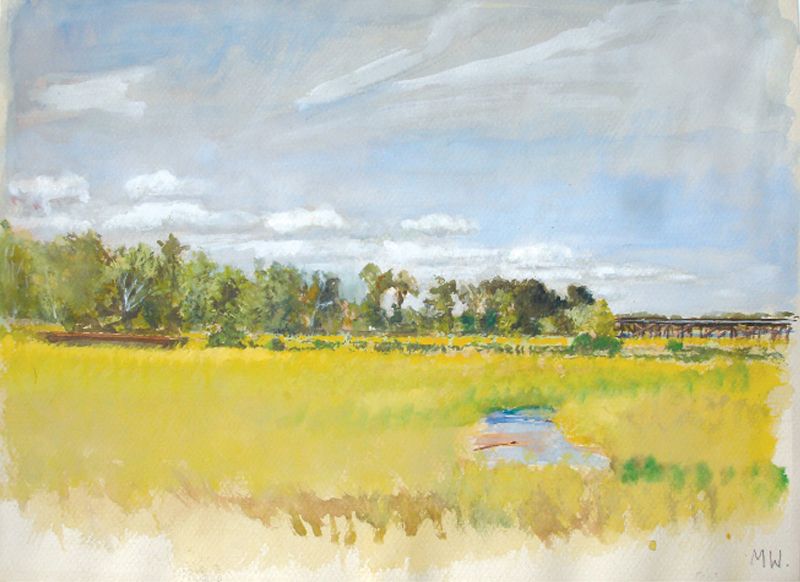Paying attention to the rise and fall, and to what the water brings

Studio View by Manning Williams, courtesy of Corrigan Gallery
On a sailboat we called the Eel Pye, we’d drifted right up to a dozen or more dolphins that were in a swirl, almost a frenzy, of fishing. It was a summer afternoon on the Fort Johnson side of the harbor, where the water was mixing with a changing tide. It was one of those scenes that gets seared in memory, a little movie to be played later—the dolphins’ slippery gray backs rising over and over, twisting in water that popped with a school of silvery fish.
Tides come and go, and things happen. On that old 22-foot Eel Pye, we’d let the rush of the changing tide pull us. The boat was moored in Wappoo Creek, a channel that connects the Ashley River end of the harbor with the Stono River. The currents there are famously strong, and we decided to make the most of it. I’d strap on flippers and jump in, swimming against the flow, and then turn around and let the water pull me back to the boat. It was such easy floating. And whenever I dunked under, I would hear so much life. Unlike freshwater lakes, where all you hear is your own splashes, the riverbed offered up a constant clicking (of crabs? oysters?) and bubbles rising. The creek water on my lips tasted salty and thick, like a tea of pluff mud and decaying marsh grass.
I loved to swim from that boat, until she was sold, but there are other stories of tides and boats and dolphins. One summer evening, on a swim around the pools and sandbars that build and fade with the tides on Sullivan’s Island, two dolphins surfaced so near and so many times I thought I’d get to touch one. I watched and called to them as the sun lowered, and they eventually swam off.
Back over near James Island, the currents and tides once brought in a beautiful wooden yacht that stretched at least 30 feet, with CONTESSA lettered in gold paint across her transom. We were out on a fall afternoon ride in the johnboat when we first saw her, stranded and abandoned in a creek off the Stono. For the next few weeks, we kept checking on the once-elegant boat, passing near.
Before long, the Contessa started a slow tilt in the low tides, and the lean got more exaggerated each day. We’d
motor up sometimes and touch the wooden hull, and, when the tide was good for getting there, we ferried a few friends out for their own close-up look. Everyone made up stories about the impressive boat’s past—where she had come from, who owned her and left her, and why. But we never knew the real story, only what we could imagine. Then one day, the Contessa was gone. In my mind, I pictured the tides and mud had finally swallowed her.
Yesterday afternoon on a run over the Stono River Bridge, I looked down at the same swelling water and wondered what’s next. Around here, that six feet or so of ocean is always coming and going—mixing things up and adding a little mystery. Just the way I like it.